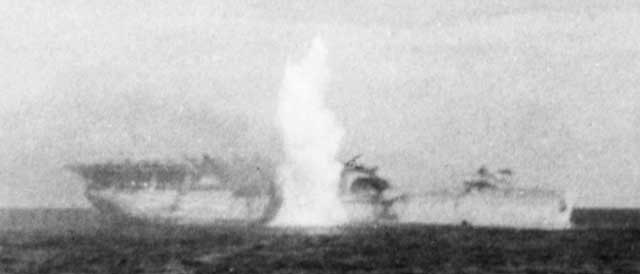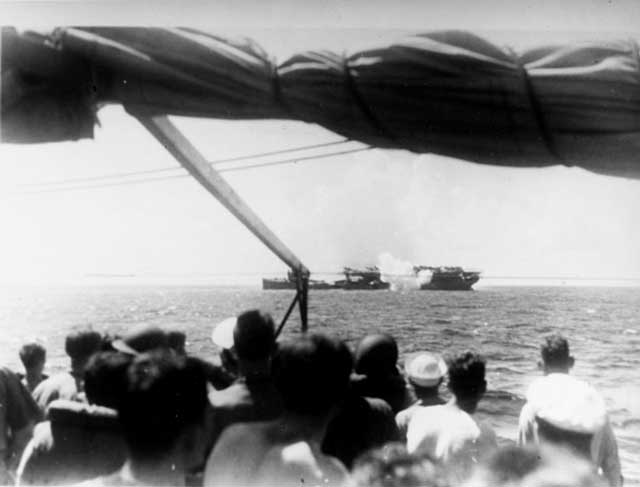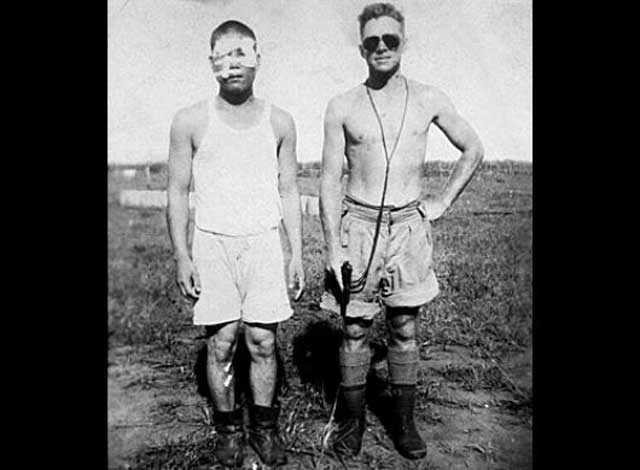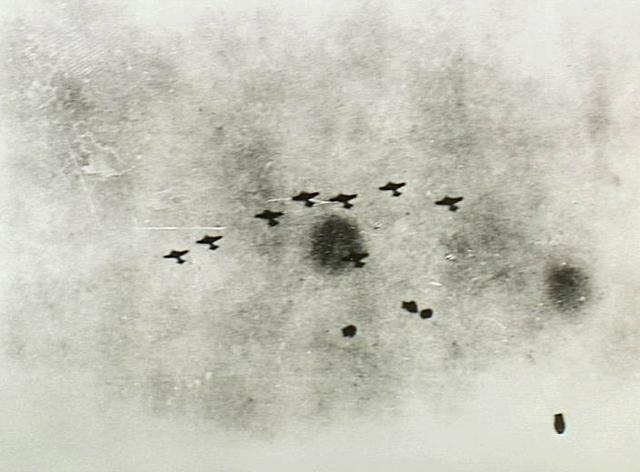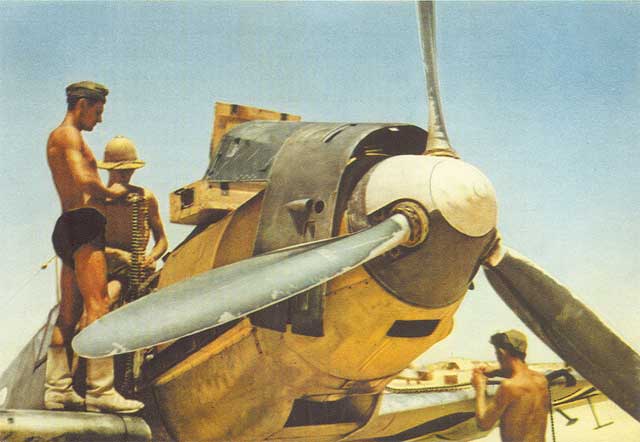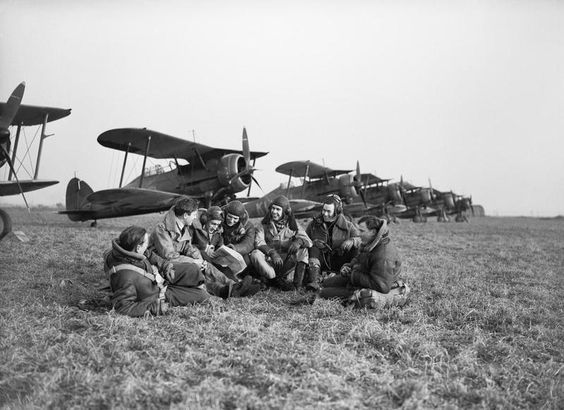Sunday 1 March 1942
 |
| HMS Exeter is hit by a torpedo fired by Japanese destroyer Inazuma during the Second Battle of the Java Sea, 1 March 1942. |
Battle of the Pacific: The naval situation of the Allies in the southwestern Pacific goes from bad to worse on 1 March 1942 when they lose another cruiser and two destroyers. Combined with the earlier Battle of the Java Sea and Battle of Sunda Strait, this action leaves the Allies without a naval presence near Java.
Damaged during the First Battle of Java Sea, Royal Navy cruiser HMS Exeter (famous for helping to destroyer German heavy cruiser Admiral Graf Spee in 1939) is ordered on 28 February to leave immediately from Surabaya to Ceylon for repairs. The decision comes just before the Japanese Navy sweeps the sea later that night in the Battle of Java Sea. At nightfall, Exeter and escorting destroyers HMS Encounter and USS Pope depart from the main north entrance (rather than the less obvious southern one) of the harbor due to Exeter's draft. The seas are swarming with Japanese, ships, and they spot Exeter at 04:00 on 1 March. They elude their pursuer, but the Japanese sight them again at 09:35. Heavy cruisers Haguro and Nachi, accompanied by destroyers Kawakaze and Yamakaze, approach and cause the Exeter to change course to the northeast. However, this only leads the British ships toward another group of Japanese warships (heavy cruisers Ashigara and Myōkō and destroyers Inazuma and Akebono). At 10:20, the ships begin firing at each other. At 11:20, a shell hits Exeter's boiler room, slowing it to four knots, and the Japanese cruisers close in. Exeter sinks at 11:40 about 90 miles (78 nautical miles and 140 km) northwest of Bawean. Both destroyers are sunk soon after, Encounter after her captain orders her scuttled and Pope by dive bombers. While the Japanese rescue 652 men from Exeter, 152 of them perish in Japanese custody.
 |
| HMS Exeter sinking on 1 March 1942 (U.S. Navy photo NH 91772 from the U.S. Navy Naval History and Heritage Command, captured by US forces on Attu Island in 1943). |
With the seas now cleared of large Allied warships, the invasion of Java continues without serious interruption. The first landings begin just after midnight at around 00:15. Japanese transport ships unload troops at Bantam Bay in West Java (near Merak and Eretan Wetan) and Kragan in East Java. Facing little opposition, the Japanese in the western force quickly sets up its headquarters at Serang, while the eastern force takes Kalidjati airfield by noon. The Allied defenders send defensive forces to the landing zones during the day, but they do not arrive in numbers large enough to counterattack until 2 March.
 |
| The Second Battle in the Java Sea, 1 March 1942. Heavy cruiser Myoko and Ashigara are firing on the Exeter. |
In the Philippines, the front is quiet but the Allied position is withering. The 34th Pursuit Squadron has been engaged in heavy fighting for two months and is down to its last two planes. The Japanese, however, also are taking heavy casualties, having lost 2700 killed and 4000 wounded. The difference between the two sides is that the Japanese can easily bring in reinforcements from the north, while the Allies are effectively blockaded by the oppressive Japanese sea and air presence.
 |
| Dutch freighter Rooseboom, sunk west of Sumatra on 1 March 1942. |
 |
| President Polk, sunk near the Gilbert Islands on 1 March 1942. |
Japanese submarine HIJMS I-25 launches its Yokosuka E14Y1, Navy Type 0 Small Reconnaissance Seaplane "Glen" to perform reconnaissance over Hobart, Tasmania. As on its other flights, the seaplane carries out its mission without being spotted.
 |
| Destroyer USS Pope (DD-225) sinking on 1 March 1942 during the Second Battle of the Java Sea. This photo was taken from a Japanese floatplane. |
After almost two weeks of indecision about whether to even approach Hitler with the idea of another retreat, today Fourth Army General Heinrici arrives at the Fuhrer headquarters in Rastenburg to plead his case with Hitler. Hitler, however, already is thinking about operations elsewhere to regain the initiative and rescue the trapped units at Kholm and Demyansk and is not concerned about the troops near Moscow. To Heinrici's (and everyone else's) astonishment, Hitler immediately grants the withdrawal request. He explains that previously he had been "deliberately obstinate" about retreats, but the front situation has improved so much in recent weeks that he no longer cares exactly where it is. Heinrici returns to headquarters with permission to pull troops back from an exposed position at Yukhnov.
 |
| Guns of Japanese cruiser Myoko firing during the Second Battle of the Java Sea, 1 March 1942. |
 |
| HMS Exeter sinking after the Second Battle of Java Sea, 1 March 1942. |
Battle of the Atlantic: U-656 (Kptlt. Ernst Kröning), on its second patrol out of Brest, is bombed and sunk by a Lockheed PBO-1 Hudson (VP-82 USN) south of Cape Race, Newfoundland. An unlucky boat, U-656 sinks or damages no ships during its career. There are no survivors of the 45 aboard. This U-boat sinking by an airplane is a rare event for this period of World War II.
Battle of the Mediterranean: Royal Navy submarine HMS Unbeaten sinks 3415-ton Vichy French tanker PLM.20 5 nautical miles east of Mehedia (Mahdia), Tunisia.
US/British Relations: Winston Churchill rightfully fears a Japanese expansion into the Indian Ocean. Today, he informs President Roosevelt of the Royal Navy's desire to land troops at Diego Suarez, Madagascar. Madagascar is under Vichy French control, and already there are Japanese submarines around India. The invasion is still tentative at this point, however, and no plans have been prepared.
Canadian Military: The Canadian Women's Army Corps receives full Army status as "a Corps of the Active Militia of Canada." Before this, the only women's units admitted to this status were the nursing sisters.
 |
| Auschwitz 2. |
Also on 1 March 1942, Auschwitz Birkenau (also known as Auschwitz 2) is established. It is intended to house Soviet prisoners of war but ultimately becomes the main extermination camp at Auschwitz.
 |
| One of the first ration books (The National WWII Museum). |
By now, about 10,000 family members of US servicemen have been evacuated from Hawaii. About 20,000 remain to be shipped to California. They are taking up all of the shipping space, which leaves none for the proposed internment on the mainland (favored by the US Army) of Japanese-Americans. This indirectly blocks their removal from the islands.
Cornelius Vanderbilt III passes away in Miami Beach, Florida at the age of 68. He is most remembered for his interest in yachting and for serving honorably as a brigadier general in World War I.
The owners of the major league baseball clubs decide against allowing players who now are in the military from playing for their clubs when they are available, i.e., on leave or based nearby.
 |
| The Japanese 2d Division celebrates landing at Merak, Java, on 1 March 1942. |
February 1942
February 1, 1942: The US Navy Strikes Back
February 2, 1942: Germans Recovering in Russia
February 3, 1942: Japanese Shell and Bomb Singapore
February 4, 1942: Battle of Makassar Strait
February 5, 1942: Empress of Asia Sunk
February 6, 1942: The Christmas Island Body
February 7, 1942: The Double-V Campaign
February 8, 1942: Japan Invades Singapore
February 9, 1942: French Liner Normandie Capsizes
February 10, 1942: US Car Production Ends
February 11, 1942: Tomforce Fails on Singapore
February 12, 1942: The Channel Dash
February 13, 1942: Japanese Paratroopers In Action
February 14, 1942: RAF Orders Terror Raids
February 15, 1942: Japan Takes Singapore
February 17, 1942: Indian Troops Defect to Japanese
February 18, 1942: Battle of Badung Strait
February 19, 1942: FDR Authorizes Internment Camps
February 20, 1942: O'Hare the Hero
February 21, 1942: Crisis in Burma
February 22, 1942: Bomber Harris Takes Over
February 23, 1942: Bombardment of Ellwood, California
February 24, 1942: US Raid on Wake Island
February 25, 1942: Battle of Los Angeles
February 26, 1942: Gneisenau Eliminated
February 27, 1942: Battle of Java Sea
February 28, 1942: Battle of Sunda Strait
March 1942
March 1, 1942: Second Battle of Java Sea
March 2, 1942: Huge Allied Shipping Losses at Java
March 3, 1942: Japan Raids Western Australia
March 4, 1942: Second Raid On Hawaii
March 5, 1942: Japan Takes Batavia
March 6, 1942: Churchill Assaults Free Speech
March 7, 1942: British Defeat in Burma
March 8, 1942: Rangoon Falls to Japan
March 9, 1942: Japanese Conquest of Dutch East Indies
March 10, 1942:US Navy attacks Japanese Landings at Lae
March 11, 1942: Warren Buffett's First Stock Trade
March 12, 1942: Japan Takes Java
March 13, 1942: Soviets Attack In Crimea Again
March 14, 1942: The US Leans Toward Europe
March 15, 1942: Operation Raubtier Begins
March 16, 1942: General MacArthur Gets His Ride
March 17, 1942: MacArthur Arrives in Australia
March 18, 1942: Japan Attacks In Burma
March 19, 1942: Soviets Encircled on the Volkhov
March 20, 1942: "I Shall Return," Says MacArthur
March 21, 1942: Germans Attack Toward Demyansk
March 22, 1942: Second Battle of Sirte
March 23, 1942: Hitler's Insecurity Builds
March 24, 1942: Bataan Bombarded
March 25, 1942: Chinese Under Pressure in Burma
March 26, 1942: Win Or Die, Vows MacArthur
March 27, 1942: The Battle of Suusari
March 28, 1942: The St. Nazaire Commando Raid
March 29, 1942: The Free Republic of Nias
March 30, 1942: Japanese-Americans Off Bainbridge Island
March 31, 1942: Japanese Seize Christmas Island
2020


